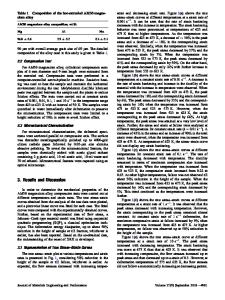Deformation behavior of blended elemental ti-6ai-4v compacts
- PDF / 3,606,645 Bytes
- 9 Pages / 603.28 x 788 pts Page_size
- 56 Downloads / 219 Views
Fig. 14--Cyclically deformed specimen, as in Fig. 13. The TEM micrograph shows an alpha region containing an unusually high density of dislocations which are pinned (p) at micropores. []2]6] zone axis. VOLUME 14A, APRIL 1983--767
Fig. 15--Cyclically deformed specimen, as in Fig. 13. Slip concentration occurs at relatively large pores, in this case at a micropore that is greater than 1 ~ m in size. The slip traces indicate (0001) basal slip bands which have cut through small angle boundaries (SB).
IV.
SUMMARY AND CONCLUSIONS
1. Ti-6A1-4V compacts produced by cold-pressing and sintering a blend of elemental Ti with A1-V powder was found to be homogeneous within individual alpha or beta regions. Small fluctuations in composition were observed in different grains. 2. The compacts contained two populations of pores, termed macropores and micropores. The macropores were located at boundaries between grains or lamellae and have sizes of up to several tens of/xm. They are believed to be residual void space that was not filled in by shrinkage during sintering, and occasionally they contain inclusions. The micropores (smaller than 1 ~m) were located within individual alpha regions. EDAX analysis showed them to be essentially clean. Their morphologies are defined by (0001) and {1]-01} bounding surfaces, which must be low energy crystal surfaces in the alpha titanium. The origin of the micropores is not clear. It is suggested that they may develop from internal voids in the titanium sponge or possibly by a Kirkendall mechanism. 3. The good yield and ultimate tensile strength, as well as the good ductility of the sintered alloy, are attributed to: (a) high sintered density, (b) low aspect ratio morphology, and (c) uniform slip distribution within the alpha regions on both prismatic {1100} and pyramidal {1]01} planes, even in the vicinity of micropores. It was not possible to obtain TEM data on slip in the vicinities of macropores. 4. The mechanical behavior in cyclic deformation is inferior to that of wrought material. This can be understood on 768--VOLUME 14A, APRIL 1983
the basis that the larger pores promote localized slip on basal (0001) planes. This observation was made for a relatively large micropore, with the suggestion that the still larger macropores will have a similar effect. The small micropores, on the other hand, appear to be beneficial as they act as obstacles to dislocation slip.
ACKNOWLEDGMENTS This research was sponsored, in part, by the Materials Laboratory/AFWAL, Wright-Patterson Air Force Base, Ohio, and by Imperial Clevite Corporation, Cleveland, Ohio. One of us (G. W.) acknowledges research support by the Deutsche Forschungs-und Versuchsanstalt fur Luft-und Raumfahrt (DFVLR), Krln, West Germany, during the summer of 1981 and the use of the electron microscopy facilities at DFVLR.
REFERENCES 1. F.H. Froes, D. Eylon, G.E. Eichelman, and H.M. Burte: J. of Metals, 1980, vol. 32, no. 2, p. 47. 2. C.A. Kelto, B.A. Kosmal, D. Eylon, and F.H. Froes: Titanium Powder Metallurgy, TMS-AIME Symposium Proceedi
Data Loading...










